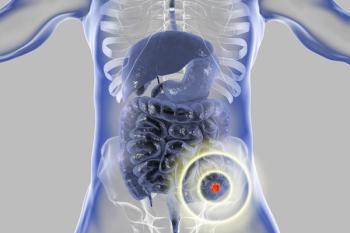
MRD and Decision-Making in Early-Stage Colorectal Cancer
This article reviews MRD and decision-making in early-stage colorectal cancer and includes insights from Christopher Lieu, MD, of the University of Colorado School of Medicine in Denver, and Daniel Ahn, DO, of the Mayo Clinic in Phoenix, AZ.
Identifying patients with colorectal cancer who are at high risk for recurrence following surgical resection is currently a major challenge.1 The clinicopathologic characteristics being used to identify at-risk patients have poor predictive value, resulting in under- and overtreatment of a substantial number of patients.2 The use of circulating tumor DNA (ctDNA) as an early indicator of minimal residual disease (MRD) in early-stage colorectal cancer was the topic of discussion in a recent OncView™ featuring insights and perspectives from Christopher Lieu, MD, from the University of Colorado School of Medicine, Denver, and Daniel Ahn, DO, from Mayo Clinic in Phoenix.
The current standard of care for early-stage colorectal cancer consists of surgical resection followed by adjuvant chemotherapy (AC) in patients deemed to be at high risk of recurrence based on the presence of certain clinicopathologic features.2,3 The goal of AC is to eradicate any post-surgery MRD that is undetectable by radiographic or biochemical methods so as to prevent recurrence.2
In the absence of high-risk clinicopathological features, patients with early-stage disease are not typically offered AC as standard of care.3 Although this approach spares most patients from unnecessary exposure to chemotherapy, patients who are initially identified as low-risk can experience recurrence. Adjuvant chemotherapy would be considered for these patients if evidence of MRD is identified.
High-risk clinicopathological characteristics currently used to identify those who are at high-risk for stage 2 colon cancer and who should receive ACT include American Joint Committee on Cancer (AJCC) primary tumor stage 4 (T4; primary tumor has invaded visceral peritoneum or has invaded or adhered to an adjacent organ or structure),3 poor differentiation, lymphovascular and/or perineural invasion, obstruction or perforation at the time of surgery, and too few lymph nodes removed during surgery to assess for distant disease (defined as <12 nodes removed). Surveillance tools currently used to detect relapse in colorectal cancer include radiographic imaging and the presence of carcinoembryonic antigen (CEA) biomarker, a protein found at high levels in the tissue of a developing baby but that is normally low or absent in a healthy adult unless certain types of cancers such as colorectal cancer are present.3,4
ctDNA is fragmented DNA released from neoplastic cells into the bloodstream that carry tumor-specific genomic alterations and make up a portion of the total cell-free DNA (cfDNA) in circulation.2 Ahn explained, “Cell-free DNA is shed from all the cells in the body, including normal cells and tumor cells, and it can be detected from a routine blood draw. As tumor tissues undergo apoptosis and necrosis, fragments of this tumor-derived DNA [are] released into the bloodstream. ctDNA is the proportion of tumor [DNA] and cell-free DNA.” Emerging research suggests that ctDNA can indicate the presence of minimal residual disease (MRD) following surgical resection and predict risk of recurrence with a high degree of precision.2
Neoplastic cells in malignant tumors have a rapid cell turnover rate and are therefore continuously releasing DNA fragments into the bloodstream. These bits of DNA released into circulation undergo degradation by blood nucleases and then are cleared by the liver and kidneys. Degradation and clearance of ctDNA occurs rapidly, giving it a very short half-life, ranging from 16 minutes to 2.5 hours.2
As explained by Lieu, the short half-life of ctDNA is beneficial. “[B]ecause the half-life of ctDNA is so short, [it] represent[s] a way to test sequencing [of the tumor] in real-time without the need for tissue…[it’s] giving you a good snapshot of what’s happening in the body at that time,” he said.
The likelihood of detecting ctDNA in the bloodstream is dependent upon tumor burden. Detection rates for colon cancer are relatively high prior to surgical resection (73% and 100% for localized and metastatic disease, respectively) and much lower following surgical resection (10%-15% and 50% for stage 2 and stage 4 disease, respectively). The proportion of cfDNA that is ctDNA following curative surgery in early-stage colorectal cancer is typically less than 0.1%.2
Detection of ctDNA can be performed via polymerase chain reaction (PCR) or NGS (next-generation sequencing)-based assays. A ctDNA assay that utilizes a person’s own tumor tissue to identify target mutations requires use of NGS and is known as a tumor-informed assay.2
As Ahn explained, “Following the surgical resection of a colon primary [tumor], tumor tissue is sequenced using NGS where a personalized tumor-informed ctDNA assay is created for that individual patient. The purpose of this assay is to detect recurrence [of disease] based [on] the genomic alterations that were initially identified in the patient’s tumor tissue.”
Lieu added that “the genomic profiling of tumors through ctDNA can provide 2 really critical pieces of information. The first is that ctDNA can be detected, which means that there’s…a tumor in the body that’s releasing the ctDNA into the bloodstream. The second piece of information that’s really important is the real-time mutational profiling of the tumor, which may guide therapy.” He also added that serial ctDNA monitoring for MRD or drawing blood for ctDNA detection at regular intervals can improve the sensitivity and specificity for recurrence.
“[P]atients who are ctDNA-positive and remain ctDNA-positive over time… have [an] incredibly high risk for recurrence,” Lieu noted. “[P]atients that are ctDNA-negative and remain ctDNA-negative…[are] very, very unlikely to have a recurrence. [I]f patients are ctDNA-negative and then convert to ctDNA positivity, [they are] likely to have tumor recurrence because you’re detecting that ctDNA from the microscopic disease.”
In a recent study presented at the 2021 meeting of the American Society of Clinical Oncology (ASCO), Henriksen and colleagues provided data on the use of a ctDNA assay called SignateraTM among 218 patients with stage 1 to 3 colorectal cancer. Of the 9% (20/218) of patients with stage 1 to 3 colorectal cancer who tested positive for MRD following surgery, recurrence occurred in 75% (15/20). The recurrence rate among those who were MRD-negative following surgery was only 13.6% (27/198). In a subset analysis of this same study (n = 155), ctDNA positivity was significantly associated with relapse-free survival (HR, 7.1; P < .001), compared to CEA (HR, 1.2; P = .73). The investigators also found that post-surgical serial testing of ctDNA detected MRD up to a median of 8 months (0.56 to 21.6 months) ahead of recurrence detected via standard radiologic imaging techniques.1
Henriksen and colleagues noted that the 25% of patients who had tested positive for MRD and did not experience relapse had all been given AC.1 Lieu pointed out that this does not necessarily prove that AC was life-saving for these 5 patients, but it is a promising association that can be used as a springboard for further study.
“[T]he Henriksen study really does fit in nicely with the other studies that have been done,” said Lieu. “The main implication…is that…the presence of ctDNA [is] highly associated with relapse and that the absence of ctDNA [is associated with] a lower risk of relapse. [This and other studies] really cement ctDNA as the most impactful prognostic marker we’ve ever seen in colorectal cancer,” he said.
Genomic mutations that are driver mutations differ from those that are passenger mutations, but identifying either type in the blood can provide helpful information. As their name implies, driver mutations provide a fundamental growth advantage to cancer cells, explained Lieu, and identifying them is critical to effectively targeting metastatic disease. Lieu noted that according to 1 study, approximately 1 out of every 10 mutations detected in a cancer are considered driver mutations.
Passenger mutations, on the other hand, don’t necessarily determine the development of the cancer, nor are they predictive of the cancer’s metastatic potential. However, as Lieu pointed out, “the detection of passenger mutations can be helpful,” particularly in the setting of early-stage colorectal cancer.
A challenge with ctDNA assays is that mutations among aging hematopoietic stem cells can be misinterpreted as being positive for MRD. These mutations are referred to as clonal hematopoiesis of indeterminate potential (CHIP). However, newer ctDNA assays, such as the Signatera™ assay, have a lower false positive rate due to the elimination of both CHIP and germline mutations from its tracking set.
Both Lieu and Ahn noted that although ctDNA assays testing for MRD are not yet being used in a predictive sense to shape clinical decision-making for treatment, they are incredibly useful as prognostic indicators.
“I think we’re quickly finding that ctDNA is certainly way more prognostic than any of [our currently utilized] clinical features or any of these clinical features [used] in combination,” said Lieu. “ctDNA really is the most prognostic thing that we’ve seen in early-stage colorectal cancer. [T]he studies show almost a 100% positive predictive value [PPV] for disease recurrence if the ctDNA is present,” he explained. On the other hand, “if patients are ctDNA-negative postoperatively, and…remain ctDNA-negative, we know that [these] patients have an extremely good prognosis and that the disease-free interval in [this] group is very, very high.”
Ahn added that detection of MRD via ctDNA “is a better and more sensitive assay compared to our currently used surveillance tools.”
Regarding personalized MRD testing in colorectal cancer, Lieu said, “what we’re really interested in is the next step: Can we really act on [the] information [that is obtained from ctDNA assays]? And can that information save lives?… My opinion is that the trials that are currently underway and…in development are really going to tell us whether or not we can act on this information….In the future, we will have additional data to tell us how we might guide therapy with the use of these tests…to tell us if there’s something more that we can do for the patients with ctDNA positivity, and also if we can deescalate treatment for patients that are ctDNA-negative.”
REFERENCES
1. Henriksen TV, Tarazona N, Reinert T, et al. Circulating tumor DNA analysis for assessment of recurrence risk, benefit of adjuvant therapy, and early relapse detection after treatment in colorectal cancer patients. J Clin Oncol. 2021;39(suppl 3):Abstract 11. doi:10.1200/JCO.2021.39.3_suppl.11
2. Chakrabarti S, Xie H, Urrutia R, Mahipal A. The promise of circulating tumor DNA (ctDNA) in the management of early-stage colon cancer: A critical review. Cancers (Basel). 2020;12(10):2808. doi:10.3390/cancers12102808
3. NCCN. Clinical Practice Guidelines in Oncology. Colon cancer, version 2.2021. Accessed April 21, 2021. https:// www.nccn.org/professionals/physician_gls/pdf/colon.pdf
4. NIH. CEA Test. Updated March 2, 2021. Accessed May 21, 2021. https://medlineplus.gov/lab-tests/ cea-test/
Editor’s Note: Interview quotes slightly modified for readability.
Newsletter
Stay up to date on recent advances in the multidisciplinary approach to cancer.


















































































